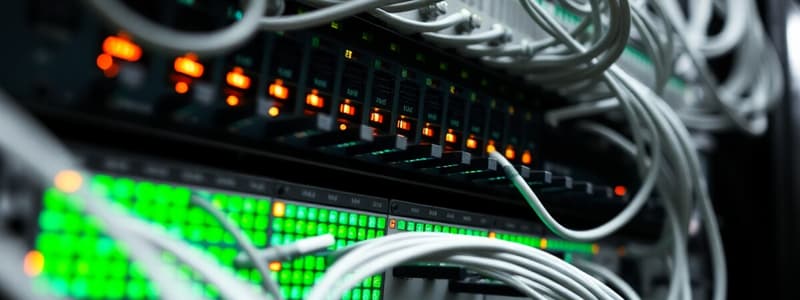Podcast
Questions and Answers
What does Frequency Division Multiplexing (FDM) primarily transmit?
What does Frequency Division Multiplexing (FDM) primarily transmit?
- Analog signals (correct)
- Voice over IP
- Digital signals
- Data packets
How does FDM ensure that signals do not interfere with one another?
How does FDM ensure that signals do not interfere with one another?
- By dividing bandwidth into non-overlapping channels (correct)
- By using digital encoding
- By allocating overlapping channels
- By compressing the signals
What is the purpose of guard bands in FDM?
What is the purpose of guard bands in FDM?
- To increase signal strength
- To allow for channel overlap
- To enhance digital transmission
- To prevent interference between adjacent channels (correct)
What is the main characteristic of Dense Wavelength Division Multiplexing (DWDM)?
What is the main characteristic of Dense Wavelength Division Multiplexing (DWDM)?
Which application commonly utilizes Frequency Division Multiplexing (FDM)?
Which application commonly utilizes Frequency Division Multiplexing (FDM)?
Which technology allows multiple optical signals to be transmitted simultaneously over one optical fiber?
Which technology allows multiple optical signals to be transmitted simultaneously over one optical fiber?
What distinguishes Coarse Wavelength Division Multiplexing (CWDM) from Dense Wavelength Division Multiplexing (DWDM)?
What distinguishes Coarse Wavelength Division Multiplexing (CWDM) from Dense Wavelength Division Multiplexing (DWDM)?
What is a key advantage of using Wavelength Division Multiplexing (WDM)?
What is a key advantage of using Wavelength Division Multiplexing (WDM)?
What is a significant disadvantage of Time Division Multiplexing (TDM)?
What is a significant disadvantage of Time Division Multiplexing (TDM)?
Which application primarily benefits from Time Division Multiplexing (TDM)?
Which application primarily benefits from Time Division Multiplexing (TDM)?
What is a primary reason for using multiplexing techniques like TDM?
What is a primary reason for using multiplexing techniques like TDM?
What factor can increase latency in TDM systems?
What factor can increase latency in TDM systems?
How does TDM handle multiple users transmitting data simultaneously?
How does TDM handle multiple users transmitting data simultaneously?
What is a primary characteristic that distinguishes TDM from other multiplexing techniques?
What is a primary characteristic that distinguishes TDM from other multiplexing techniques?
Which limitation is commonly associated with TDM in terms of network management?
Which limitation is commonly associated with TDM in terms of network management?
What is a key advantage of using TDM in communication systems?
What is a key advantage of using TDM in communication systems?
What is the primary function of Time Division Multiplexing (TDM)?
What is the primary function of Time Division Multiplexing (TDM)?
Which statement describes Synchronous TDM?
Which statement describes Synchronous TDM?
What is a potential disadvantage of Asynchronous TDM?
What is a potential disadvantage of Asynchronous TDM?
Which of the following best describes the efficiency of Asynchronous TDM?
Which of the following best describes the efficiency of Asynchronous TDM?
What is a key feature of Time Division Multiplexing?
What is a key feature of Time Division Multiplexing?
Which of the following types of TDM allows for more efficient use of bandwidth?
Which of the following types of TDM allows for more efficient use of bandwidth?
What results from the use of preassigned slots in Synchronous TDM?
What results from the use of preassigned slots in Synchronous TDM?
How does TDM relate to the concept of bandwidth efficiency?
How does TDM relate to the concept of bandwidth efficiency?
Study Notes
Multiplexing and De-multiplexing
- Multiplexing combines multiple input signals into a single output signal for transmission.
- De-multiplexing separates this combined signal back into original individual signals at the receiving end.
Benefits of Multiplexing
- Bandwidth Efficiency: Multiplexing allows multiple data streams to utilize the same channel, maximizing available bandwidth.
- Cost Reduction: Reduces the number of physical connections required, leading to lower costs.
- Improved Performance: Enables simultaneous connections for faster data transfer.
Bandwidth
- The maximum data transfer rate of a network.
Types of Multiplexing
- Time Division Multiplexing (TDM):
- A digital technique that allocates specific time slots for users to transmit data over a single frequency channel.
- Each user is assigned a dedicated time interval for data transmission, with data sent sequentially in frames.
- Frequency Division Multiplexing (FDM):
- An analog technique that allows simultaneous transmission of multiple signals over a single communication medium by dividing the available bandwidth into distinct frequency channels.
- The total bandwidth is divided into non-overlapping frequency channels, with each channel allocated to a different user.
- Users have exclusive access to their assigned frequency channel, enabling independent data transmission and reception.
- Guard bands (unused frequencies) are placed between channels to prevent interference.
- Wavelength Division Multiplexing (WDM):
- Enables transmission of multiple optical signals simultaneously over a single optical fiber, each signal using a different wavelength of light.
- Different wavelengths are combined onto one optical fiber for transmission, making efficient use of the fiber's capacity.
- Dense WDM (DWDM): Supports a large number of channels (up to 80) with narrow spacing, suitable for high-capacity applications.
- Coarse WDM (CWDM): Supports fewer channels (up to 18) with wider spacing, used for lower-capacity applications.
- Code Division Multiplexing (CDM):
- Allows multiple users to transmit data simultaneously over one channel using unique codes.
- Each user has a distinct code that spreads their signal.
- Data signal is expanded for wider bandwidth, making it difficult to intercept or jam.
Advantages of Multiplexing
- Efficient bandwidth use: Multiple signals share a single channel.
- Increased data capacity: More data can be sent at once.
- Scalability: Easy to add more users without major changes.
- Flexibility: Different types (TDM, FDM, WDM, CDM) cater to various needs.
Disadvantages of Multiplexing
- Synchronization Issues: Keeping data streams aligned can be challenging.
- Latency: Combining signals can introduce delays.
- Signal Degradation: Long distances can weaken signals.
- Resource Management: Requires careful planning to avoid congestion.
Data Communication
- The exchange of data between devices through a transmission medium.
- Involves sending and receiving information in the form of signals.
- The main components are the sender, receiver, and the transmission medium.
Transmission Media
- The physical path through which data is transmitted.
Guided Media
- Physical media that guide the signal.
- Copper Cables: Includes twisted pair cables (Ethernet cables) and coaxial cables, which use electrical signals to transmit data.
Studying That Suits You
Use AI to generate personalized quizzes and flashcards to suit your learning preferences.
Related Documents
Description
This quiz covers the fundamental concepts of multiplexing and de-multiplexing, alongside their benefits in network communication. Explore various types of multiplexing techniques like Time Division Multiplexing (TDM) and Frequency Division Multiplexing (FDM). Test your understanding of bandwidth efficiency and performance improvements.




